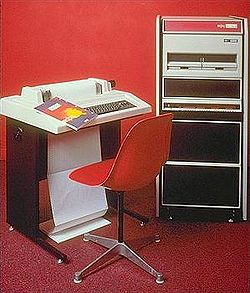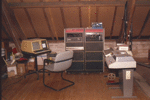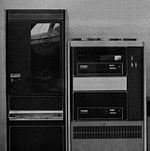Difference between revisions of "PDP-11/05"
(Add mention of two different CPU backplane versions) |
(Add 3rd system version) |
||
| Line 8: | Line 8: | ||
}} | }} | ||
| − | The '''PDP-11/05''' was the fourth processor in the [[PDP-11]] series, following the [[PDP-11/20]], the [[PDP-11/45]] and the [[PDP-11/40]]; it used the | + | The '''PDP-11/05''' was the fourth processor in the [[PDP-11]] series, following the [[PDP-11/20]], the [[PDP-11/45]] and the [[PDP-11/40]]; it used the KD11-B CPU. It was intended as a cost-reduced low-end machine to replace the PDP-11/20. Like all the other early PDP-11's, it was a [[UNIBUS]] machine. |
| − | The | + | The KD11-B was a two-board [[micro-programming|micro-programmed]] processor contained on two [[DEC card form factor|hex]] cards. |
The PDP-11/05 was identical to the [[PDP-11/10]]; the only difference between the /05 and the /10 was the number on the front panel. The /05 was aimed toward the [[OEM]] market, while the /10 was intended for end-users. | The PDP-11/05 was identical to the [[PDP-11/10]]; the only difference between the /05 and the /10 was the number on the front panel. The /05 was aimed toward the [[OEM]] market, while the /10 was intended for end-users. | ||
| Line 16: | Line 16: | ||
==Backplane versions== | ==Backplane versions== | ||
| − | The PDP-11/05 and /10 came in | + | The PDP-11/05 and /10 came in three versions, with different main backplanes (the 9-slot unit holding the two CPU cards). |
| − | + | The original /05 and /10 came with 9-slot CPU backplanes wired to hold [[MM11-L]] 16Kbyte core memory units. There were two different configurations: one version held two memory units, with one slot left for [[SPC]] devices; the other held one memory unit, with four SPC slots. | |
| + | |||
| + | A second version, the /05N and /10N, came in a 10-1/2 inch box and a slightly different backplane, which had space for two MM11-L memory units, but deleted the SPC slot and replaced it with a slot to hold | ||
| + | the dual M9970 console terminal cable board. | ||
| + | |||
| + | The later /05S and /10S came with a backplane wired to hold an [[MM11-U]] 32Kbyte core memory, and provided three SPC slots. | ||
==CPU board versions== | ==CPU board versions== | ||
Revision as of 14:17, 26 February 2016
| PDP-11/05 | |
 a PDP11/05 from a sales brochure. | |
| Manufacturer: | Digital Equipment Corporation |
|---|---|
| Architecture: | PDP-11 |
| Bus Architecture: | UNIBUS |
The PDP-11/05 was the fourth processor in the PDP-11 series, following the PDP-11/20, the PDP-11/45 and the PDP-11/40; it used the KD11-B CPU. It was intended as a cost-reduced low-end machine to replace the PDP-11/20. Like all the other early PDP-11's, it was a UNIBUS machine.
The KD11-B was a two-board micro-programmed processor contained on two hex cards.
The PDP-11/05 was identical to the PDP-11/10; the only difference between the /05 and the /10 was the number on the front panel. The /05 was aimed toward the OEM market, while the /10 was intended for end-users.
Backplane versions
The PDP-11/05 and /10 came in three versions, with different main backplanes (the 9-slot unit holding the two CPU cards).
The original /05 and /10 came with 9-slot CPU backplanes wired to hold MM11-L 16Kbyte core memory units. There were two different configurations: one version held two memory units, with one slot left for SPC devices; the other held one memory unit, with four SPC slots.
A second version, the /05N and /10N, came in a 10-1/2 inch box and a slightly different backplane, which had space for two MM11-L memory units, but deleted the SPC slot and replaced it with a slot to hold the dual M9970 console terminal cable board.
The later /05S and /10S came with a backplane wired to hold an MM11-U 32Kbyte core memory, and provided three SPC slots.
CPU board versions
The two boards in the PDP-11/05-10 (the M7260 data paths module, and the M7261 control logic module) both come in two markedly-different versions, but unlike later practise (as in, e.g. the PDP-11/34), the two versions are not given different M-numbers, or clearly marked with a revision (i.e. 'M7260' and 'M7260-AA') on the handles.
One easy way to visually distinguish the early M7260 from later ones is that the later ones contain a circular selector switch in the upper left corner to select the baud rate of the built-in serial line; also, the position of the large UART chip has a different location (from down near the contact fingers, to up near the handles) and orientation (parellel to the board's long axis, in the earlier revision). For the M7261, the early version of the board has a large blank area, containing only traces, in the left middle area of the board.
The early revision of the M7260 is the 'B' revision; the later is the 'C' revision (the latter is marked as such, on the back side of the board- "M7260C"). For the M7261, two early revisions are the 'C' and 'E' revisions (the latter also similarly marked - "M7261E"); the later is the 'F' (also marked).
The early version of the M7260 only supports 110 baud operation; the latter has a circular selector switch which allows operation at a range of speeds from 110 baud up to 2400 baud; however, it is necessary to tweak a trim pot to change from the 110/220/440/880/1760 speed set to the 150/300/600/1200/2400 set.
The later revision of the M7261 contains two jumpers which are not present on the earlier revision. One (W1) disables to built-in serial line (which is 20mA, and limited to 2400 baud), allowing use of a more capable serial interface as the system console. The other (W2) disables the CPU from acting as a bus arbitrator, so that the machine can be a 'slave' processor, on a UNIBUS controlled by another CPU.
Gallery
| v • d • e PDP-11 Computers and Peripherals |
|---|
| UNIBUS PDP-11s - PDP-11/20 • PDP-11/15 • PDP-11/35 • PDP-11/40 • PDP-11/45 • PDP-11/50 • PDP-11/55 • PDP-11/70 PDP-11/05 • PDP-11/10 • PDP-11/04 • PDP-11/34 • PDP-11/60 • PDP-11/44 • PDP-11/24 • PDP-11/84 • PDP-11/94 QBUS PDP-11s - PDP-11/03 • PDP-11/23 • PDP-11/23+ • MicroPDP-11/73 • MicroPDP-11/53 • MicroPDP-11/83 • MicroPDP-11/93 QBUS CPUs: LSI-11 • LSI-11/2 • KDF11-A • KDF11-B • KDJ11-A • KDJ11-B • KDJ11-D • KDJ11-E Buses: UNIBUS • UNIBUS map • SPC • MUD • EUB • QBUS • CD interconnect • PMI Also: PDP-11 architecture • PDP-11 Extended Instruction Set • FP11 floating point • PDP-11 Memory Management |
| UNIBUS CPUs: KA11 • KC11 • KB11-A • KB11-B • KB11-C • KB11-D • KD11-A • KD11-B • KD11-D • KD11-E • KD11-EA • KD11-K • KD11-Z • KDF11-U
Co-processors: FP11-A • FP11-B • FP11-C • FP11-E • FP11-F • KE44-A • FPF11 Chips: LSI-11 • KEV11-A • KEV11-B • KEV11-C • F-11 • KEF11-A • KTF11-A • T-11 • J-11 • FPJ11 CPU options: KE11-E • KE11-F • KJ11-A • KT11-C • KT11-D • KK11-A • KK11-B • KT24 • KTJ11-B Rare CPU options: KS11 Memory Protection and Relocation option • KT11-B Paging Option • KUV11 Writeable Control Store Front panels: KY11-A • KY11-D • KY11-J • KY11-LA • KY11-LB • KY11-P More on buses: UNIBUS and QBUS termination • Bus Arbitration on the Unibus and QBUS • CTI BUS PDT-11s - PDT-11/110 • PDT-11/130 • PDT-11/150 CTI PDP-11s - PRO-325 • PRO-350 • PRO-380 Other: FIS floating point • PDP-11 Commercial Instruction Set • PDP-11 stacks • PDP-11 family differences |



